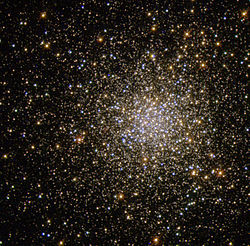

 14h39m36.5s, −26° 32′ 18.0″
14h39m36.5s, −26° 32′ 18.0″| NGC 5694 | |
|---|---|

The core of NGC 5694 imaged by the Hubble Space Telescope
| |
| Observation data (J2000 epoch) | |
| Class | VII[1] |
| Constellation | Hydra |
| Right ascension | 14h39m 36.5s[2] |
| Declination | −26° 32′ 18.0″[2] |
| Distance | 114,100ly[1] |
| Apparent magnitude (V) | 10.2[1] |
| Apparent dimensions (V) | 3.6′[1] |
| Physical characteristics | |
| Metallicity | ![{\displaystyle {\begin{smallmatrix}\left[{\ce {Fe}}/{\ce {H}}\right]\end{smallmatrix}}}](https://wikimedia.org/api/rest_v1/media/math/render/svg/4c0821bd80891e071c08e7c7ee8e022baedf522c) = –1.74[3] dex = –1.74[3] dex |
| Estimated age | 13.44 Gyr[3] |
| Other designations | Caldwell 66 |
| See also: Globular cluster, List of globular clusters | |
NGC 5694 (also known as Caldwell 66) is a globular cluster in the constellation Hydra. It was discovered in 1784 by William Herschel.
This globular cluster is located at a distance of 114,000 light-years (35,000 pc) from the Sun and 96,000 light-years (29,000 pc) from the Galactic Center[4] and is one of the oldest known globular clusters in the Milky Way Galaxy, forming nearly 12 billion years ago.[5]
Its chemical composition is highly peculiar, being highly (to nearly solar levels) enriched in alpha elements, suggesting an extragalactic origin before being captured by the Milky Way.[6]
|
| |
|---|---|
| List |
|
| See also |
|
| |
|
| |||||||||||||||
|---|---|---|---|---|---|---|---|---|---|---|---|---|---|---|---|
| |||||||||||||||
| Stars |
| ||||||||||||||
| Star clusters |
| ||||||||||||||
| Nebulae |
| ||||||||||||||
| Galaxies |
| ||||||||||||||
| Galaxy clusters |
| ||||||||||||||
| Astronomical events |
| ||||||||||||||